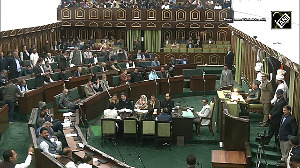FemtoCells -- a new technology that boosts indoor coverage of mobile phone networks, thus reducing call drops and signal failures -- is fast catching the fancy of Indian telecom operators like Reliance Communications (RCom) and Bharti Airtel.
Though not commercially available in the country, the technology's efficient spectrum utilisation, simplicity of installation (a plug-and-use device) and low cost (around $200 in international markets) are reasons enough to tout it as the next big thing in the telecom world.
FemtoCells can be termed as small indoor base transceiver stations (BTS) for cellular networks. The devices can be plugged into a customer's broadband Internet connection to make calls or use data services over normal mobile phones, while inside a building.
The technology is being used in developed countries to encourage subscribers to use mobile phones, rather than fixed lines.
"The signals from BTSes give a good coverage to telecom users outside the offices or residential premises, but inside a building the signals tend to be weak. This affects the quality of the calls," said Krishnan Natarajan Iyer, senior architect, Sasken Communication Technologies.
Sasken is into designing of hardware and software for global FemtoCells manufacturers.
The installation of this technology inside office and residential premises will help reduce call charges due to the system's spectrum efficiency.
FemtoCells would become a reality in the country by early next year, and on a mass deployment the prices would drop to as low as $100 per unit, he added.
According to an industry source, major companies like RCom and Bharti Airtel have begun pilot testing of the technology.
RCom is testing the technology for both its GSM and CDMA services while other players are expected to jump on to the bandwagon soon. The companies would place large orders for the technology and equipment in this quarter and the FemtoCell boxes are expected to be installed by all operators.
This would pave the way for technology providers like the US-based Ubiquisys (in which Google has a stake), ip.access and RadioFrame to enter into the country. Alcatel-Lucent, which already has an Indian presence, is another manufacturer of this technology.
The technology supports both 2G and 3G networks and is compatible with WiFi, broadband, WiMax and Voice over Internet Protocol (VoIP) among others.
Apart from providing in-building connectivity, the technology would also enable reduction of BTSes (a cost saving for operators) and help in massive expansion of networks. Calls routed through this technology are cheaper due to its spectrum efficiency -- more calls supported by the same amount of spectrum -- and charges are much below than that of fixed-line networks.
"Operators stand to benefit as they will not have to increase the number of BTSes, which, in turn, will reduce their operational costs," Iyer said.
Telecom service providers are of the opinion that neither licence nor prior permission from the regulator is needed for the installation of the technology.
This is a plug-and-play device, meaning one can buy and install it right away. If this becomes a reality, then in 2008 there will not be any call drops, signal failures or other connectivity issues.








 © 2025
© 2025